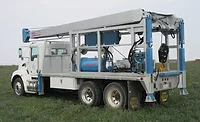Pump Hoist Trends
“Not that many years ago, the drilling contractors were satisfied with a basic, hard-working and dependable pump hoist,” notes Virgil Hunke, president of Smeal Manufacturing Co. “Today, they're more like parade vehicles. They're getting bigger and fancier with more bells and whistles.” That being said, Hunke reports that the T5 is Smeal's most popular model. He calls the T5 their “Ford Taurus of pump hoists.”
Asked about current trends in the industry, Hunke points to the well rehabilitation market as having a strong impact on the pump hoist business. “With the plastic casing and stainless screen, the wells can last almost forever,” he explains.
A relative newcomer to the field, REICHdrill Inc. introduced its pump hoists in December of 2003. Sales manager Jim Hughey explains his firm's strategy: “Traditionally in the pump hoist market, the rigs have been built piecemeal-style. We took a different approach - our concept was to put together a complete package - truck, 6,000-pound, single-line pull unit and most of the bells and whistles together in one packaged unit - and market it that way. We get a lot of requests from people asking 'What can I buy just the hoist for?' or 'Can I furnish my own truck?' So far, we've declined those types of requests. At some point, we very well might but right now, we aren't.”
Hughey continues: “Applying some of our drill manufacturing experience to the hoist, we got rid of all of the mechanical linkages between the winches and the controls. We hosed and hard-piped everything back to the control station at the right rear of the machine. And we offer a hydraulically extendable boom. We're mounting these pump hoists on the new GMC 5500 Series truck. It's called the Eagle 1 and it features a Duramax diesel and an Allison automatic transmission. We do offer it on a Ford truck as well; we call that the Eagle 2.”
Asked about current market conditions, Hughey says, “The tax incentive that was up at the end of last year had some bearing on people's buying decisions in 2004. It remains to be seen how that will affect things this year. The water well market always has had its peaks and valleys but the peaks are never too high and the valleys are never too low for very long so overall, things are fairly steady.”
Semco Inc. offers nine different pump hoist models. John Sutphin, the company's general manager, says, “Our most popular units are the S6000 and the S25000; it's been that way for a few years. The 6000 fits most domestic projects and the 25000 takes care of the shallow oil and gas and the large turbine people.”
Sutphin highlights some of the S6000's distinct features: “The 6000 is hydraulic-extendable so you can stop anywhere you want. It leans back 13 feet, 6 inches. It has a two-speed winch so you can run either 120- or 240-feet-per-minute and it's shiftable on the go. It features a 30-gallon oil tank so you don't have to run an oil cooler. An open-center hydraulic system means it only builds pressure when you're pulling a lever.”
Asked about the remote controls, Sutphin tells us, “We have both the standard and wireless remotes available. The standard ones are more popular - by a 3-to-1 margin. The thing about the wireless units is if you're around an airport or a refinery where they have radar, they can be trouble. Or if the battery goes dead - then you're out of luck.”
“We've got a new aluminum pump hoist on the drawing board,” says Sutphin, looking to the future. “The DOT provisions in some states say 10,000 pounds is the heaviest vehicle you can have on the road before you have to deal with lots of paperwork and stopping at the port of entry. We've designed a 1-ton truck we can put an aluminum body on with an aluminum derrick so we can stay within those limitations and out of the next category.”
Albin Jan-ecek, president of Pul-star Mfg. Inc., is quite excited about his company's recent new option offering - patent-pending hy-draulic pipe racks. “They were introduced at the last South Atlantic Well Drillers Jubilee and then in the western part of the country at the national convention in Las Vegas. It took quite a few years of engineering and development,” he explains, adding that the reaction from contractors was superlative. “We have three out in the field and currently a dozen on order.” Lead-time is 12 to 20 weeks, depending on models and the time of the year.
Pulstar offers nine pump hoist models, ranging from the P4,000 to the P88,000. “The P10,000 is, by far, the biggest seller,” reports Janecek. Compared to five or 10 years ago, “The contractors are looking for more high performance. And high performance can be defined as faster and more powerful.”
Going where the action is, Pulstar is concentrating much of its resources these days on the domestic water market. “The domestic side of the marketplace seems to be booming,” explains Janecek. “The commercial/industrial side seems to be improving but still lags behind the domestic market.”
Asked what the future might bring as far as new Pulstar products and systems, Janecek tells us there are several things on the drawing board but that we'll have to wait to see them.
ND
Tsunami Relief
BNP Media, publisher of National Driller magazine, has made a $25,000 donation to the American Red Cross' International Response Fund, on behalf of its proud employees. The fund is dedicated to helping those affected by the horrific devastation of the recent tsunami disaster. To make a personal donation to the fund, please visit www.redcross.org.Looking for a reprint of this article?
From high-res PDFs to custom plaques, order your copy today!





